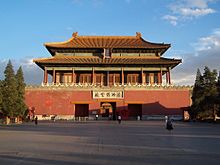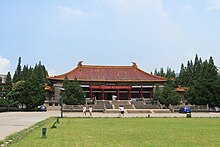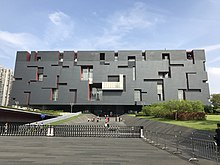In ancient times Jilin was inhabited by various peoples, notably the Mohe and the Wùjí (勿吉). It also formed a part of the Goguryeo kingdom. The kingdom of Balhae was established in the area from 698 to 926 AD. The region then fell successively under the domination of the Khitan Liao Dynasty, the Jurchen Jin dynasty, and the Mongol Yuan Dynasty. During the Qing Dynasty, much of the area was under the control of the General of Jilin, whose area of control extended to the Sea of Japan to encompass much of what is Russia's Primorsky Krai today. Immigration of Han Chinese was strictly controlled.

A Major Historical and Cultural Site Protected at the National Level, often abbreviated as guobao, is one of 5,058 monuments listed as of significant historical, artistic or scientific value by the State Administration of Cultural Heritage, which is the cultural relics administrative department of the State Council of China. This is the highest level of cultural heritage register in China at the national level, although there are much wider registers of protected sites at the provincial level, the city level, and so on.

The Changsha Jiandu Museum is a history museum located at No. 92 of Baisha Road in Tianxin District, Changsha, Hunan, China. It is adjacent to Baisha Well in the south and Tianxin Pavilion in the west. Changsha Jiandu Museum is currently a large-scale modern themed museum dedicated to the collection, preservation, arrangement, study, and exhibition of bamboo and wooden slips (Jiandu). It covers an area of 14,100-square-metre (152,000 sq ft).

The Memorial Hall of the War to Resist US Aggression and Aid Korea, also translated as the Korean War Museum, is a museum in Dandong, Liaoning. It is the only official museum in China that memorializes the Korean War. First established in 1953, it was rebuilt at its current location in October 1990. The new museum was opened on 27 July 1993, the 40th anniversary of the Panmunjom armistice. Since 2014 it has been closed for refurbishment. It was reopened on 9 September, 2020.

Hangzhou Museum, formerly "Hangzhou History Museum", is a national first-grade museum in Hangzhou, Zhejiang, China.

The Jilin Provincial Museum is a first-grade museum in Changchun, Jilin province, China, dedicated to history and art. It is a subordinate unit of the Jilin Province Department of Culture and Tourism.

Xi'an Museum is a museum on Youyi West Road, Beilin District, Xi'an, Shaanxi Province, China. Xi'an Museum had its official opening on 18 May 2007, "National Museum Day", with a total investment of 220 million RMB and a total area of 160,000 square meters. The complex includes three parts: the museum proper, the Tang-era Small Wild Goose Pagoda and Jianfu Temple historic area, and the museum gardens.

Wenzhou Museum is a museum run by the city of Wenzhou, located on Shifu Road, Lucheng District.


















